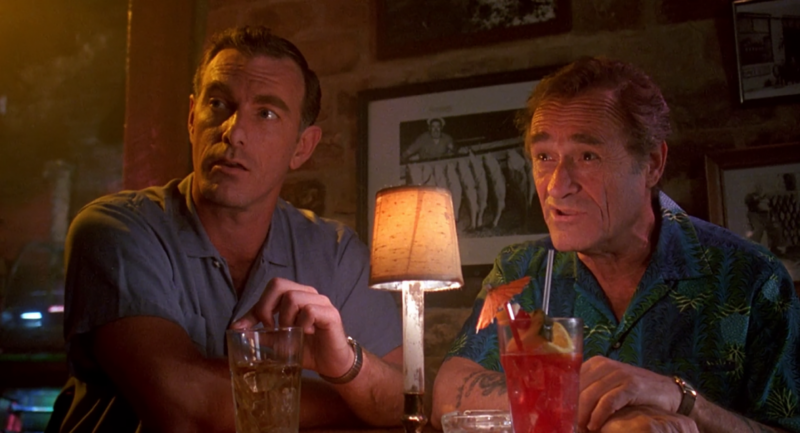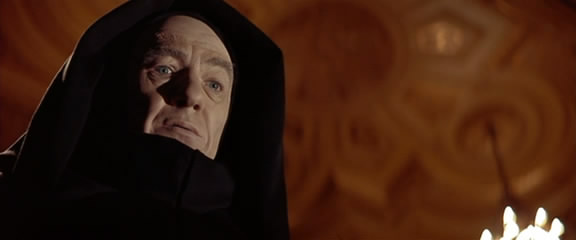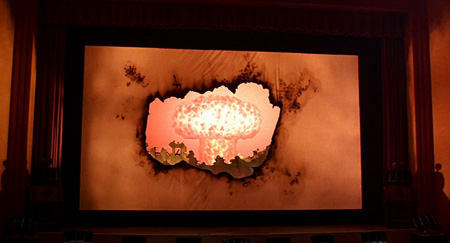— Joe Dante, interview with The AV Club
— Chief Clancy Wiggum
In 1993, movie audiences looking for a good time could go watch a movie about an audience watching a movie as a metafictional mutual parasitism between fiction and the real. Or they could watch a movie about an audience watching a movie as a metaphor for the benefits of fake bullshit in the face of real reality and the perils of real bullshit creating fake reality. They ultimately watched Jurassic Park.

And while the movie is tonally all over the place, large parts of it are a joke — spoofing Arnold himself and the kind of action Black helped define. After young wiener Danny is transported into the latest flick in the Jack Slater franchise via the much-mocked magic ticket, he finds himself teamed up with a ludicrously violent Arnold who shoots sticks of dynamite (Acme, of course) out of the air and henchman into the air — this movie sets the record for airborne henchfolk — and on one occasion into an ice cream truck. Which promptly explodes. McTiernan previously shot action enhanced but straight in stuff like Predator, here he leans into the insanity without sacrificing clarity and the bloodshed is laughable but still entertaining as violence.
The parody runs thick at this point, in ways cleverly metafictional (Arnold Schwarzenegger does not exist in Jack Slater’s world, Sly Stallone starred in Terminator 2) and amusing but over the top (a roll call of increasingly wacky buddy cop partnerships at the police station culminates with Whiskers, a cartoon cat). A mafioso’s farting corpse — no boner — is a plot point. Danny helpfully and points out plot points and dramatic beats, the best bit comes when Jack’s partner is clearly evil because he’s played by F. Murray Abraham “and he killed Mozart!”

A talking (anthropomorphic detective and to be honest sort of a perv) cat?!
“How do you feel when you find out someone made you up?” Slater wonders. We saw earlier that Jack Slater saw his son die in his previous movie — at the hands of The Ripper (an absolutely terrifying Tom Noonan), but Slater realizes now at the hands of a scriptwriter and an actor, making him dance for the amusement of people like Danny. Danny and a friend try to cheer Slater up — there are worse things than movies, like sickness, pain, politicians even. You don’t have it that bad! But no one likes being a pawn, and it’s pretty easy to read a meta-commentary on the real Schwarzenegger here as he was clearly growing tired of the action genre. And Arnold the actor is affecting as a guy discovering he may not be a demigod but could actually be a man, his listening to the real Mozart on the radio after a franchise (an eternity?) of hard rock is delightful.

Director Joe Dante and screenwriter Charlie Haas use real footage from October 1962 whenever possible, and John F. Kennedy announcing that nuclear missiles are now 90 miles away from Key West, the movie’s setting, is far more disturbing than the Taxi Driver aping of Hero’s bad old New York City. Adults arm the beaches and riot over groceries, but the movie generally follows the viewpoint of Gene and his brother Dennis and their friends who are aware of this terrifying reality but generally focus on more mundane matters. Gene and Dennis’ dad, a Navy man, is out somewhere on the blockade that might trigger the apocalypse, and they can’t think about that. So they go to the movies.

No, he absolutely planned to tap into something. “War stuff spooks ’em and we come in!” Woolsey exclaims early on, with John Goodman capturing the ebullience of a man who loves the con more than the money that comes in from it (although not much more). He is an exploitation filmmaker, and what better to exploit than the End Times themselves? The realer the threat, the bigger the scare — while Black agonizes about what he puts his characters through, Woolsey cheerfully throws his characters at atomic death and takes the money of those fearing that very death for real.
And he doesn’t take that money for granted, hiring John Sayles and a mean-ass Dick Miller to pose as protesters objecting to the movie on moral grounds — all the better to drum up attention. The eyes-open Gene recognizes Miller as a bit actor in previous Woolsey flicks and Woolsey takes Gene under his gregarious wing, recognizing a fellow clever person who can see behind the curtain but can still be entertained by the lies and unreality out front.
As opposed to the lies he’s swimming in every day. A class where a teacher intones the importance of three daily servings from the “red meat food group” is interrupted by a nuclear drill where all concerned go to the hall and, of course, duck and cover. Except for the aptly-named Cassandra, a student who the quiet and straitlaced Gene finds himself drawn to — she rants about how radiation will have you throwing up organs no matter how hard you clutch your hands over your head. “They don’t tell you the truth!” she shouts as she’s dragged to the principal’s office.
Dante specializes in letting lunacy loose in staid situations — paranoia running amok in the burbs, little green men destroying a small town, those same little green men upending technocracy in the Haas-scripted Gremlins 2. But while McTiernan embraces a cartoonishness that’s more classical Dante in style in Hero, Dante strips things down here to capture a madness that is bigger than his usual intrusive anarchists. The people in charge have let it come to this, the world about to burn at the push of a button. That’s reality, and the craziest part is how the people in charge tell you to live with it, a fakeness deeper than any movie.

Both movies climax, of course, at the movies. Dance’s villain decides to assassinate Arnold Schwarzenegger at the premiere of the Jack Slater movie we began this movie watching, reasoning killing Arnold will kill Jack. Plenty of cameos (MC Hammer! Chevy Chase! Jim Belushi!) and a few run-ins with Arnold himself (who can’t stop talking about Planet Hollywood) later, Jack kills the bad guy, but a gunshot that would be a flesh wound in his world has him on the brink of death. Er, Death — the magic ticket finds a repertoire screening of The Seventh Seal and brings in cinema’s most famous Grim Reaper (Ian MacKellen here) to make a judgment. “He’s not on my lists,” Death intones. “I don’t do fiction, not my field.” And here we have the great leveler in the movie buff’s eyes — we have real lives and real deaths, but the Jack Slaters of the world are immortal. They live as long as there are screens.

One of the finest moments in Gremlins is the little monsters wreaking havoc in a movie theater but hushing in awe as Snow White begins playing, and Dante stages the same scene here — a packed theater of rowdy kids and not a few adults is at a near-riot when the movie starts, but they immediately fall under its spell. Before the show, Woolsey rallies the ushers and ticket-takers and concession workers, telling them they’re all a part of the movie magic he’s about to unleash. Ruth has heard it a million times before but it is phenomenally effective bullshit, and Woolsey himself believes at least some of it. He tells Gene earlier about the joy of walking into a movie theater that mirror the words of Dante himself up above: “Here I am! What have you got for me?”
What he has for the masses is garbage. A pretty good ant mask is the high point of stilted acting, flat direction and dialogue that is atrociously repetitive when it is not condescending (the lead scientist constantly explains concepts to the female lead, played by Ruth — “the image is magnified, or larger”). It is played entirely straight (apparently chunks of dialogue are lifted directly from stuff like The Amazing Colossal Man) and it is howlingly funny because of this. But it works for the audience, not in the least because of Woolsey’s gimmicks, like sparks flying in an assault and shocks to seat bottoms — the latter a nod to Castle’s The Tingler.

Manny Farber famously placed White Elephant Art — portentous, trying for importance — in opposition to Termite Art, whose creators “seem to have no ambitions towards gilt culture but are involved in a kind of squandering-beaverish endeavor that isn’t anywhere or for anything.” Last Action Hero is too clever and self-aware to be a white elephant but it’s at least an albino mastodon — a huge expenditure of money and talent to replicate a huge expenditure of money and talent in service of a grand statement of art’s value — that drowned in a tar pit of indifference and insult. The previews on my VHS, as for any good franchise, advertise the film’s soundtrack and videogame (we suspiciously see no footage of the latter in its ad). What if they built a universe and nobody came? Matinee is a termite film that honors termites, the churned-out trash that got in the heads of its creators and made them want to create. Its VHS preview exhorts you to “ask your video dealer about purchasing a previously-viewed copy of Matinee!” — it can’t even imagine you wanting to lay down real money for a new copy. But it’s the smarter and ultimately starker statement of what art can mean and what it can’t.
Last Action Hero closes with Jack Slater back on the job. He has a nice moment where he tells his fulminating chief that he’s not going to play by the Hollywood rulebook anymore and hey, you can almost believe it. The final shot is Jack driving away into the Los Angeles sunset. It’s the end of his movie, and the end of Last Action Hero. A Hollywood ending.
“You think adults know what they’re doing?” Woolsey asks Gene and Cassandra as he and Ruth head out of town. “It’s a hustle. Grown-ups are making it up as they go along.” And he muses to Ruth as they drive away that (just like a franchise character that won’t die), there’s always something else coming, something that will bring the world to the brink again. “At least those kids will get a jump on it,” he says with a wry grin. “They’ve seen the sneak previews.” And as Gene and Cassandra sit on the beach, watching our boys come home, the camera picks up a helicopter and cuts to a shot of it head-on — an image recognizable from any footage, real or fictional, of Vietnam. Holds the shot. Cuts to black. The next feature is about to begin.


